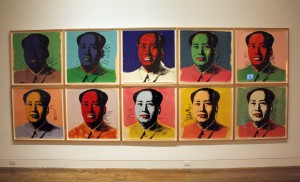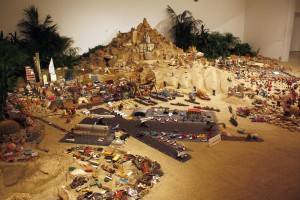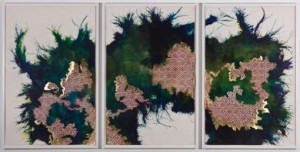
By Christopher Trela & Catherine Del Casale | NB Indy
What is avant-garde?
According to Dan Cameron, chief curator at Orange County Museum of Art, the phrase the avant-garde “is a phenomenon that occurs (or, if you prefer, occurred) relative to a specific historical moment of quite limited duration, in which the art or artist referred to was leading the charge, in the front ranks—it is a military expression, after all—of the latest reliably disruptive manifestation of the new.”
A disruptive manifestation of the new is an apt description for OCMA’s current exhibition, The Avant-Garde Collection, that focuses on innovative works created over the past 50 years.
The Avant-Garde Collection is organized by Cameron and Assistant Curator Fatima Manalili, who said the exhibition came about after they were brainstorming what pieces from OCMA’s permanent collection they could present.
“I wanted to show our gems, how we can show a lot of it all at once, which got us thinking about how artists are producing works that carry on the avant-garde tradition of doing something new and working from the

history of those before them,” said Manalili.
“We thought we had to cut off at a certain point in time, but the museum has acquired a lot of things that are cutting edge, so it’s almost a century of work that was avant-garde at the time of their creation.”
The exhibition includes approximately 100 artworks that include painting, sculpture, assemblage, installation art, and video.
The largest piece in the exhibition is also one of the most intricate and fascinating: “A Tale of Two Cities” by Chris Burden, which includes 5,000 war toys from America, Japan and Europe.

“It was originally made in 1981, but this version is dated 1987,” said Cameron. “We just finished doing a major restoration of the work. It took a team of three or four people working three weeks straight to install. It depicts two cities in the 25th century when the world is reduced to city states, and a battle is waged between big city and little city.”
Cameron explained that they used hundreds of photographs taken of the original installation to recreate the piece.
“This collection really showed a diverse range of avant-garde pieces throughout the 1960s to the 21st century using a variety of mediums,” acknowledged Catherine. “One of my favorites was the piece by Sherin Guirguis, which featured hand cut paper with mixed media and gold embellishments across three screens. I also liked the Untitled installation by Doug Sheeler (a square white light in a stark white room), which shifted attention away from the light object itself and to the effect the light and shadow has on the space around it. The shadows the object made become the main focus while the piece itself fades away.”
And the Avant-Garde Collection will fade away no January 4, so see it while you can.
For more information, visit OCMA.net.




